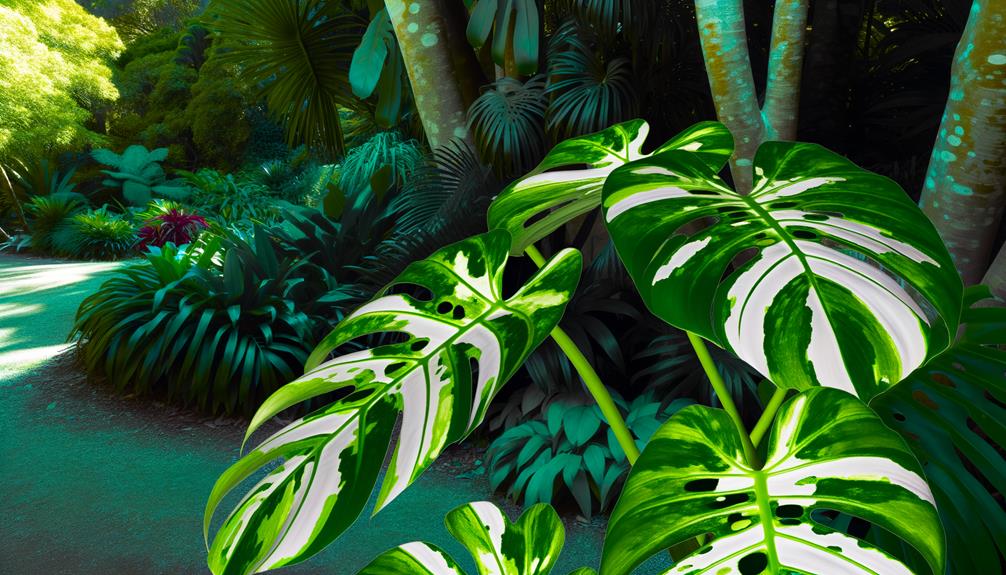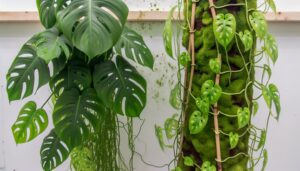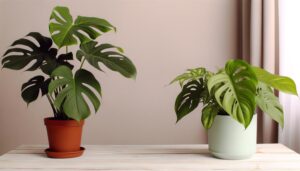Monstera Deliciosa Albo Variegata Australia
Monstera deliciosa 'Albo Variegata' is highly sought after in Australia for its distinct white and green variegation, resulting from a genetic mutation. Indigenous to Central and South America, this plant thrives in bright, indirect sunlight and temperatures between 18-27°C (65-80°F).
Ensure proper drainage, aerated soil with humidity levels of 60-80%. Use monthly fertilizers during the growing season.
Watch out for pests like spider mites and mealybugs, and keep the soil consistently moist but not waterlogged. Propagate using stem cuttings, and choose reputable sellers for consistent variegation.
There's much more to discover about this exquisite plant.

Key Takeaways
- Monstera deliciosa 'Albo Variegata' is highly popular in Australia for its striking variegated foliage.
- It thrives in bright, indirect sunlight and requires high humidity and well-draining soil.
- Ideal temperature range for growth is 18-27°C (65-80°F), with monthly fertilization during growing season.
- Prune selectively to promote variegation, and regularly inspect for pests like spider mites and mealybugs.
- Prices vary by variegation and size; buy from reputable sellers with phytosanitary certificates.
Origin and History
Monstera deliciosa 'Albo Variegata', originally hailing from the tropical rainforests of Central and South America, has a rich history intertwined with botanical exploration and horticultural fascination. You'll find its origins tracing back to regions like Mexico, Panama, and Colombia.
Botanists first documented the species Monstera deliciosa in the 18th century, but the variegated variety, 'Albo Variegata,' gained prominence later. This cultivar captivated plant enthusiasts with its striking white and green variegation.
The plant's journey to Australia involved careful propagation and selective breeding to guarantee genetic stability. In Australia, it's become a coveted specimen among collectors and horticulturists alike, reflecting both its exotic origins and the global demand for unique, aesthetically pleasing houseplants.
Unique Characteristics
The 'Albo Variegata' cultivar features striking white and green variegation resulting from a rare genetic mutation, making it a visually stunning specimen for any collector. This variegation occurs due to the lack of chlorophyll in sections of the leaf, resulting in patches of white alongside the typical green.
You'll notice that the variegation patterns are highly irregular and unique to each leaf, which adds to the plant's allure. Additionally, the Monstera deliciosa Albo Variegata exhibits fenestrations—natural leaf splits—that increase as the plant matures, contributing to its distinctive appearance.
The stems also display variegation, which further enhances its ornamental value. Its aerial roots, essential for stability and nutrient absorption, are robust and prominent, reflecting its epiphytic nature.
Ideal Growing Conditions
To cultivate Monstera deliciosa Albo Variegata successfully, make sure it receives bright, indirect sunlight and maintains a consistent temperature range between 18-27°C (65-80°F).
This plant thrives in well-draining, aerated soil; use a mix of peat moss, perlite, and orchid bark for peak root health. Ensure the pot has drainage holes to prevent waterlogging, which can lead to root rot (Rhizoctonia solani).
Maintain humidity levels between 60-80% to replicate its tropical origins; a humidifier can help in drier climates. Water when the top 2-3 inches of soil are dry, avoiding overwatering.
Fertilize monthly during the growing season with a balanced, water-soluble fertilizer (20-20-20 N-P-K) to support vigorous growth. Regularly wipe leaves to remove dust and facilitate photosynthesis.
Light Requirements
Securing ample light exposure is crucial for Monstera deliciosa Albo Variegata, needing bright, indirect sunlight to maintain its variegation and overall health. Place your plant near an east or west-facing window, where it can receive filtered light throughout the day. Direct sunlight can scorch its leaves, causing harm. Use sheer curtains to soften intense light.
Under low light conditions, the plant may lose its distinct variegation, as chlorophyll production compensates for insufficient light. Aim for a light intensity of 10,000 to 20,000 lux for best growth. If needed, supplement with full-spectrum grow lights.
Regularly rotate the plant to ensure consistent light exposure, promoting balanced, symmetrical growth. Proper light management will help your Monstera thrive.
Watering Needs
While ideal lighting conditions are vital for the health of Monstera deliciosa Albo Variegata, understanding its watering needs is equally essential for maintaining its vibrant variegation and robust growth.
You'll need to keep the substrate consistently moist but not waterlogged. Overwatering can lead to root rot (Phytophthora spp.), whereas underwatering may cause leaf browning and reduced variegation. Check the soil's moisture level by inserting your finger about 2 inches deep; if it feels dry, it's time to water. Use room-temperature, filtered water to avoid mineral buildup. Make sure drainage holes are present to prevent stagnation.
Soil Preferences
When selecting soil for your Monstera deliciosa 'Albo Variegata', make sure it's a well-draining mix to prevent root rot. Aim for a slightly acidic to neutral pH level, ideally between 5.5 and 7.0.
Balance moisture retention with aeration by incorporating components like perlite and peat moss.
Well-Draining Soil Mix
For best development, Monstera deliciosa 'Albo Variegata' needs a well-draining soil mix consisting of materials like perlite, orchid bark, and peat moss to prevent root rot and maximize aeration.
Perlite, a volcanic glass, boosts drainage and prevents compaction. Orchid bark, usually sourced from pine or fir, enhances aeration and imitates the plant's natural epiphytic habitat. Peat moss, sphagnum-based, retains moisture while providing slight acidity.
Blending these components creates a medium that supports strong root systems and optimal nutrient absorption. Combine around 40% perlite, 30% orchid bark, and 30% peat moss for an ideal mix. Regularly check soil moisture to avoid overwatering.
This specific soil combination guarantees your Monstera flourishes in a controlled, well-ventilated setting.
Ph Level Requirements
Your Monstera deliciosa 'Albo Variegata' thrives best in soil with a pH level between 5.5 and 7. This slightly acidic to neutral range guarantees peak nutrient uptake. To measure soil pH, use a pH meter or test strips. Here's a quick guide to the pH levels and suitable soil types:
| pH Level | Soil Type | Description |
|---|---|---|
| 5.5-6.0 | Slightly Acidic | Ideal for nutrient absorption |
| 6.1-7.0 | Neutral | Balanced nutrient availability |
| Below 5.5 | Highly Acidic | Risk of nutrient deficiencies |
Maintaining the correct pH level supports healthy root development and vibrant variegation. Regularly test your soil to make sure it stays within this prime range. Adjustments can be made using lime to raise pH or sulfur to lower it.
Moisture Retention Balance
Maintaining ideal moisture content in the soil is crucial for the health and growth of Monstera deliciosa 'Albo Variegata'. You should choose a well-draining, aerated soil mix that balances moisture and oxygen.
Combine equal parts of peat moss, perlite, and orchid bark to create an excellent medium. Peat moss ensures moisture retention, perlite enhances aeration, and orchid bark promotes drainage.
Avoid waterlogged conditions, as they result in root rot (Pythium spp.). Check moisture levels by inserting your finger 1-2 inches into the soil; water only when the top inch feels dry.
Consistent, even moisture encourages vigorous growth and variegation. Implementing these practices will assist you in maintaining the delicate equilibrium necessary for this stunning variegated cultivar.
Fertilization Tips
Proper fertilization of Monstera deliciosa Albo Variegata involves using a balanced, water-soluble fertilizer with an N-P-K ratio of 20-20-20. Apply this fertilizer biweekly during the active growing season, typically from spring to early autumn. Dilute the fertilizer to half the recommended strength to avoid over-fertilization, which can lead to root burn and nutrient imbalances.
Monitor the plant's foliage for signs of nutrient deficiency, such as yellowing leaves or stunted growth, and adjust your fertilization schedule accordingly.
Avoid fertilizing during the dormant winter months, as the plant's metabolic rate decreases, reducing nutrient uptake. Additionally, consider incorporating micronutrients like magnesium and iron to support the best variegation and overall plant health.
Pruning Techniques
Pruning Monstera deliciosa Albo Variegata involves strategically eliminating damaged or excessive growth to maintain the plant's health and promote desirable variegation. Begin by sterilizing your pruning shears with isopropyl alcohol to prevent pathogen transfer.
Identify leaves showing chlorosis or necrosis and cut them close to the node. Eliminating these leaves reallocates energy to healthier foliage. Additionally, trim any aerial roots that are excessively long or unruly.
For promoting variegation, selectively prune green leaves to encourage the growth of variegated ones. Always make clean, angular cuts to facilitate rapid healing.
Regular inspection and pruning mitigate overcrowding and promote optimal light penetration, enhancing photosynthesis. Follow these guidelines to maintain a thriving, aesthetically pleasing Monstera deliciosa Albo Variegata.
Common Pests
While maintaining your Monstera deliciosa Albo Variegata through regular pruning, be vigilant for common pests like spider mites (Tetranychus urticae) and mealybugs (Pseudococcidae) that can compromise its health.
Spider mites are minute arachnids that create fine webbing on the undersides of leaves, often leading to stippling and foliage discoloration. Mealybugs, recognizable by their white, cotton-like exteriors, cluster in leaf axils and along stems, secreting honeydew that encourages sooty mold growth.
To combat these pests, utilize insecticidal soap or neem oil, ensuring thorough coverage of affected areas. Regularly inspect the foliage and maintain ideal humidity to deter infestations.
Prompt identification and treatment are essential to preserving the vitality and variegation of your Monstera deliciosa Albo Variegata.
Propagation Methods
To propagate Monstera deliciosa 'Albo Variegata', you'll need to master stem cutting techniques, which involve selecting a healthy node.
You can then choose between water propagation, where the cutting is placed in water to develop roots, or soil propagation, which requires planting the cutting directly in a well-draining potting mix.
Each method has specific advantages and care requirements to guarantee successful growth.
Stem Cutting Techniques
Stem cutting propagation for Monstera deliciosa Albo Variegata involves selecting a healthy section of the vine with at least one node and an aerial root. You'll need sterilized pruning shears to make a clean cut below the node, minimizing damage to the plant tissue.
Confirm the chosen stem has variegated leaves, as new growth inherits these patterns. After cutting, let the stem callous over for a few hours to prevent rot.
Prepare a pot with a well-draining soil mix, such as a blend of perlite and peat moss, to support root development. Insert the cutting into the soil, burying the node and aerial root, and maintain high humidity to encourage rooting.
Monitor for new growth.
Water Propagation Tips
For successful water propagation of Monstera deliciosa Albo Variegata, make sure you select a healthy cutting with at least one node and an aerial root. Submerge the node in water, ensuring the aerial root remains above the waterline to prevent rot. Use a clear container to monitor root development, and change the water every 5-7 days to maintain oxygen levels and prevent bacterial growth.
Place the container in indirect sunlight, as direct sunlight can cause algae growth and heat stress. Roots will typically develop within 2-4 weeks. Once the roots reach approximately 2-3 inches (5-7 cm) in length, the cutting is ready for progress. This method maximizes hydration and oxygenation, promoting robust root formation.
Soil Propagation Guide
When propagating Monstera deliciosa Albo Variegata directly in soil, start by selecting a healthy cutting with at least one node and an aerial root. Use a sterile, sharp knife to make a clean cut just below the node.
Prepare a well-draining soil mix composed of equal parts perlite, orchid bark, and high-quality potting soil. Plant the cutting with the node and aerial root buried about an inch deep. Water thoroughly, ensuring the soil is moist but not waterlogged.
Place the pot in a warm, humid environment with indirect sunlight. Monitor the moisture level, and avoid letting the soil dry out completely. Within a few weeks, new roots should start to develop, signaling successful propagation.
Popularity in Australia
Monstera deliciosa 'Albo Variegata' has surged in popularity across Australia due to its striking variegated foliage and unique aesthetic appeal.
The plant's leaves exhibit a mesmerizing mix of green and white, caused by a genetic mutation leading to variegation. Enthusiasts are drawn to the fenestrated leaves with their perforations, scientifically known as leaf fenestrations.
You'll find this plant featured prominently in urban jungles, interior design projects, and horticultural collections. Its phototropism, the tendency to grow towards light, makes it an engaging specimen to cultivate.
Social media platforms amplify its charm, with hashtags like #MonsteraAlboVariegata trending among plant aficionados. As a result, the demand for this variegated Monstera species continues to outpace supply, solidifying its status as a coveted botanical gem.
Buying and Pricing
When purchasing Monstera deliciosa Albo Variegata, you'll notice market price trends vary greatly based on variegation patterns and plant size. To secure a healthy specimen, consider buying from reputable sellers who provide phytosanitary certificates.
Monitoring online plant forums and local nurseries can also offer insights into fair pricing and availability.
Market Price Trends
In the current market, prices for Monstera deliciosa 'Albo Variegata' in Australia exhibit significant variability due to factors such as variegation patterns, plant size, and overall health.
Specimens with higher variegation ratios (e.g., 50% white to green) command premium prices due to their rarity and aesthetic appeal. Larger plants with established root systems are more expensive than juvenile specimens, reflecting their maturity and growth potential. Healthy plants, free from pests and diseases (e.g., spider mites, root rot), also fetch higher prices.
Market fluctuations are influenced by seasonal availability and demand trends. You'll notice that prices can range from AUD 200 for small, minimally variegated specimens to over AUD 1,000 for large, highly variegated, and healthy plants.
Purchasing Tips
To make sure you make an informed purchase of Monstera deliciosa 'Albo Variegata', closely examine the variegation patterns, root health, and overall importance of the plant. Variegation should be stable, showing consistent white or cream patches without reverting to green. Check for Phytophthora root rot or signs of Pythium, making certain roots are firm and white.
Inspect the aerial roots for vigor, indicative of a healthy Monstera. Evaluate leaf fenestration; mature plants exhibit more splits and holes. Price varies significantly based on variegation quality and plant size.
Verify the seller's reputation and confirm they adhere to phytosanitary regulations. Consider purchasing from specialized nurseries or reputable online platforms to ensure authenticity and best plant health.
Conclusion
Embracing the Monstera deliciosa 'Albo Variegata' is like inviting a piece of Eden into your home. With its stunning variegation and unique foliage, it's no wonder this plant captivates Australian plant enthusiasts.
By providing the correct light, water, and care, you'll secure its lush, healthy growth. Remember, propagation can be your key to sharing this botanical treasure.
So, why not let this Monstera transform your space into a verdant paradise?






